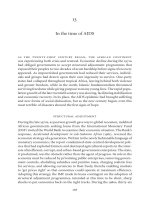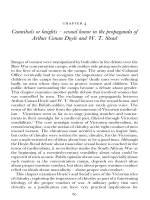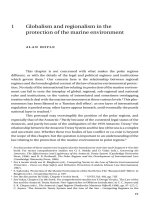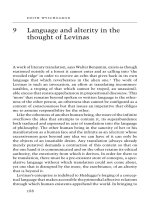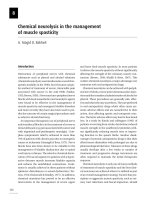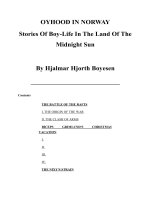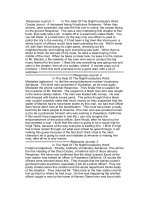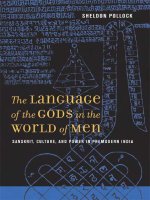Rhoda blumberg commodore perry in the land of gun (v5 0)
Bạn đang xem bản rút gọn của tài liệu. Xem và tải ngay bản đầy đủ của tài liệu tại đây (2.99 MB, 128 trang )
Commodore Perry in the Land of the Shogun
by Rhoda Blumberg
For my husband, Gerald
and my son, Lawrence
I want to thank my friend Dorothy Segall, who helped me
acquire some of the illustrations and supplied me with source
material from her private library.
I’m also grateful for the guidance of another dear friend
Amy Poster, Associate Curator of Oriental Art
at the Brooklyn Museum.
• Table of Contents
Part I The Coming of the Barbarians
1 Aliens Arrive
2 The Black Ships of the Evil Men
3 His High and Mighty Mysteriousness
4 Landing on Sacred Soil
The Audience Hall
5 The Dutch Island Prison
6 Foreigners Forbidden
7 The Great Peace
The Emperor • The Shogun • The Lords • Samurai • Farmers • Artisans and Merchants
8 Clouds Over the Land of the Rising Sun
The Japanese-American
Part II The Return of the Barbarians
9 The Black Ships Return
Parties
10 The Treaty House
11 An Array of Gifts
Gifts for the Japanese • Gifts for the Americans
12 The Grand Banquet
13 The Treaty
A Japanese Feast
14 Excursions on Land and Sea
A Birthday Cruise
15 Shore Leave
Shimoda • Hakodate
16 In the Wake of the Black Ships
Afterword
The First American Consul • The Fall of the Shogun
Appendices
A Letter of the President of the United States to the Emperor of Japan
B Translation of Answer to the President’s Letter, Signed by Yenosuke
C Some of the American Presents for the Japanese
D Some of the Japanese Presents for the Americans
E Text of the Treaty of Kanagawa
Notes
About the Illustrations
Bibliography
Searchable Terms
About the Author
Other Books by Rhoda Blumberg
Credits
Copyright
About the Publisher
Steamships were new to the Japanese.
courtesy of Asahi Shimbun and Kanagawa Prefecture Museum
PART I
THE COMING OF THE BARBARIANS
The Black Ships arrive, July 8, 1853.
courtesy of the Historiographical Institute of the University of Tokyo
1 • ALIENS ARRIVE
IF MONSTERS HAD DESCENDED UPON JAPAN the effect could not have been more terrifying.
People in the fishing village of Shimoda were the first to spot four huge hulks, two streaming
smoke, on the ocean’s surface approaching the shore. “Giant dragons puffing smoke,” cried some.
“Alien ships of fire,” cried others. According to a folktale, smoke above water was made by the
breath of clams. Only a child would believe that. Perhaps enemies knew how to push erupting
volcanoes toward the Japanese homeland. Surely something horrible was happening on this day,
Friday, July 8, 1853.
Fishermen pulled in their nets, grabbed their oars, and rowed to shore frantically. They had been
close up and knew that these floating mysteries were foreign ships. Black ships that belched black
clouds! They had never seen anything like it. They didn’t even know that steamboats existed, and they
were appalled by the number and size of the guns.
Barbarians from out of the blue! Will they invade, kidnap, kill, then destroy everything? What
will become of the sacred Land of the Rising Sun?
General alarms were sounded. Temple bells rang, and messengers raced throughout Japan to
warn everyone that enemy aliens were approaching by ship.
Rumors spread that “one hundred thousand devils with white faces” were about to overrun the
country. People panicked. They carried their valuables and furniture in all directions in order to hide
them from invading barbarians. Women and children were locked up in their homes or sent to friends
and relatives who lived inland, far from the endangered shore.
Messengers rushed to the capital of Edo (now Tokyo) to alert government officials. Edo, the
world’s largest city with more than one million occupants, went into a state of chaos the very day the
ships were sighted. Women raced about in the streets with children in their arms. Men carried their
mothers on their backs, not knowing which way to turn.
Who could control the turmoil? The Emperor Komei was isolated in his royal palace at Kyoto.
Although he was worshiped as a divine descendent of the sun goddess, Amaterasu, he was a
powerless puppet, responsible primarily for conducting religious ceremonies. During his leisure
hours he was expected to study the classics and compose poetry. The Japanese referred to their
emperor as “he who lives above the clouds.” By law, he was not permitted to leave his heavenly
palace unless he received special permission from the government. An emperor’s sphere of influence
was otherworldly. All down-to-earth decisions were made by shoguns who had been wielding power
for more than 700 years.
The word shogun means “barbarian expelling generalissimo.” How appropriate at this time!
Surely the Shogun would take command!
But Shogun Ieyoshi who occupied the palace at Edo in 1853 was a weakling. No one even
bothered to tell him the frightening news. Three days after the ships arrived he over-heard chatter
about them while enjoying a Noh play that was being performed for him in his palace. The news
affected him so badly that he went to bed, sick at heart.
Because the Shogun was inept, his councillors, called the Bakufu, ruled the country. But
according to a Japanese reporter, “They were too alarmed to open their mouths.”1 The Bakufu should
not have been so surprised. Before reaching Japan the American fleet had stopped at Loo Choo (now
Okinawa). Japanese spies stationed there had sent word that American ships were on their way to
Japan. Dutch traders had also alerted the Bakufu. But for mystifying reasons, the government did not
take these reports seriously until the Black Ships arrived on July 8. After recovering from shock they
ordered the great clans to prepare to battle barbarians.
Locked away from the rest of the world, using the Pacific Ocean as its moat, Japan had
maintained a feudal society similar to that of Europe during the Middle Ages. There were lords
(daimyos), knights (samurai), and vassals who labored in their lord’s domain and paid tithes to their
masters.
A samurai readies for battle.
courtesy of the Metropolitan Museum of Art, Bashford Dean Memorial Collection
The country had not been at war since it invaded Korea in 1597. That was 256 years earlier.
Nevertheless, feudal lords were able to mobilize troops. Men who had never dressed for warfare
worked to get rust off spears. They placed new feathers in their families’ antique arrows. Tailors
were pressed into service so they could fix the silk cords on ancient armor, make warriors’ cloaks,
and sew cotton skull-caps that would cushion the weight of heavy helmets. Seventeen thousand
soldiers were readied for battle.
When the ships moved toward land that first day, Japanese guard boats set out to surround the
enemy. But they could not catch up with aliens whose ships were so magical that they steamed ahead
against the wind without using sails or oars.
At five o’clock in the afternoon the foreign ships anchored a mile and a half from shore, at Edo
Bay. They were less than thirty-five miles from the capital city. Beautiful cliffs, rolling green hills,
and, above all, snow-capped Mount Fuji made a breathtaking scene. After dusk, beacon fires dotted
the land, and there was an incessant toll of temple gongs.
That night a meteor with a fiery tail streaked through the sky like a rocket. An omen from the
gods! Shrines and temples were jammed. Priests told worshipers that barbarians were about to punish
them for their sins.
2 • THE BLACK SHIPS OF THE EVIL MEN
The Susquehanna was a steam-powered sailing ship.
courtesy of the National Archives
FOUR SHIPS AND 560 MEN of the U.S. Navy had created this furor. The Mississippi and the
Susquehanna were steam-powered. The Plymouth and the Saratoga were three-masted sailing ships
in tow behind the steamers. The Japanese referred to these four vessels as “The Black Ships of the
Evil Men.”
Commodore Matthew Calbraith Perry was in command of the squadron. He had not come to
invade. He hoped to be a peacemaker who would make the isolated Empire of Japan a member of
“the family of civilized nations”1 of the world. His mission was to unlock Japan’s door. It had been
slammed shut against all but a few Dutch and Chinese traders, the only ones officially allowed in for
over 200 years.
Perry expected to deliver a letter from President Millard Fillmore to the Emperor of Japan,
proposing “that the United States and Japan should live in friendship and have commercial
intercourse with each other.”2 The letter requested that ports be opened so that American ships could
obtain coal and provisions. (See Appendix A.)
America had invested seventeen million dollars in the Pacific whaling industry, and it needed
Japanese ports to replenish coal and provisions for the whalers. Whale oil was essential for lighting
and for lubricating machinery.
President Fillmore’s letter also asked that men who had been shipwrecked on Japanese shores
be treated with kindness. This point was emphasized because many American whaling ships had been
wrecked off Japan’s coast by violent storms, and their castaways had been jailed and abused.3
Perry intended to deliver the letter and sail away peacefully. He would winter in Hong Kong.
With only four ships and supplies that could last no more than one month, he would not attempt to
wait for the Emperor’s reply, but he planned to return in the spring—when he would have more
supplies and a larger fleet.
The Commodore was determined not to use force unless attacked. But he felt that he could not
trust the actions of unknown Orientals. He dared not take chances, for he remembered the Morrison,
an American ship that had sailed into Edo Bay on a peaceful mission in 1837. Its intent was to return
seven Japanese castaways to their homeland. The Japanese had opened fire and forced the ship to
leave.
Commodore Matthew C. Perry
reproduced from the collections of the Library of Congress
As a precaution, Perry’s squadron anchored in battle formation facing the shore. Cannons and
guns were loaded. All hands took up their battle stations.
Japanese guard boats approached the moored American ships. Each vessel, propelled by six to
eight standing oarsmen, was filled with about thirty soldiers. Fastening ropes to the ships, they tried
to climb on board. Commodore Perry ordered his sailors to cut the guard boats’ ropes and use pikes
and cutlasses to keep the Japanese away. A few tried to climb the Mississippi’s anchor chain. A rap
on the knuckles sent one soldier into the water. All of the Japanese soldiers howled and shouted
angrily.
Perry’s stubborn refusal to allow them on board was based on the terrible experience of another
American commodore. Seven years before, in 1846, Commodore James Biddle had anchored at Edo
Bay, hoping to deliver a letter to the Emperor from the United States government. The letter requested
trade relations between the two countries. As a friendly gesture, Biddle allowed swarms of Japanese
soldiers to come aboard. A rude soldier gave Biddle a shove that knocked him off his feet. Anxious to
keep peace, Biddle graciously accepted an apology, which was interpreted as weakness and
cowardice. Japanese officials mocked him, refused to deliver documents, and ordered him to leave at
once. Because his orders were not to create an incident, Biddle immediately sailed away.
Perry resolved that until negotiations were successful, he would not allow more than three
officials on board at a time.
A Japanese guard boat rowed close to the Commodore’s flagship, the Susquehanna. Its men
held up a scroll, written in large letters, in French, that said, “Go away! Do not dare to anchor!” Then
one of the Japanese shouted in English, “I can speak Dutch.”4 He asked to come aboard. AntÓn
Portman, Perry’s Dutch-Japanese interpreter, came on deck. He explained that the Commodore would
only allow the highest officials on his ship. When told that there was an important person in the guard
boat, he lowered a gangway ladder.
Interpreter AntÓn Portman, drawn by an unknown Japanese artist
courtesy of the Chrysler Museum
Nakajima, introduced as vice-governor of the small nearby village of Uraga, climbed up. In fact,
Nakajima was not a vice-governor but merely a minor official. He was accompanied by a Dutchspeaking interpreter.
Commodore Perry secluded himself in his cabin. He refused to be seen by a vice-governor or,
indeed, by any but the most important emissaries of the Emperor. Lieutenant John Contee was told to
speak with Nakajima. Contee explained that the Commodore’s intentions were friendly. Perry merely
wished to present a letter from the President of the United States to the Emperor of Japan. Nakajima
replied that the American ships must go to the port of Nagasaki, where there was a Dutch trading post
so that the Dutch could act as go-betweens.
Through his lieutenant, Perry let it be known that he would never go to Nagasaki and if all guard
boats didn’t disperse immediately there would be trouble. Nakajima went to the gangway, shouted an
order, waved his fan, and all guard boats except his own departed at once. When Nakajima took his
leave he promised that a higher official would see Perry the next day, Saturday, July 9.
That night, when the meteor streaked across the sky, Perry noted in his journal that this was a
favorable omen: “…we pray God that our present attempt to bring a singular and isolated people into
the family of civilized nations may succeed without resort to bloodshed.”5
3 • HIS HIGH AND MIGHTY MYSTERIOUSNESS
AT DAWN THE AMERICANS were amazed to see a boatload of artists near the Susquehanna. Using fine
brushes, ink stones, and rolls of rice paper, they were making sketches of the ships and any of the
crew they could see. Their curiosity was obviously stronger than their fear. Within a week, pictures
of the Black Ships and “hairy barbarians” were hawked in the streets and sold in shops. They were
also reproduced on souvenir banners, scrolls, fans, and towels.
Another Japanese view of Commodore Perry
courtesy of Asahi Shimbun and Kanagawa Prefecture Museum
While these artist-reporters were acting like war correspondents, the coastline was bustling with
activity. Women and children carrying baskets of dirt helped men build new fortifications. Thousands
of soldiers marched to and fro while their leaders decided upon strategic battle positions. They
displayed colorful banners emblazoned with their lords’ arms. Some trained muskets on Perry’s
squadron. Strips of canvas had been set up along the coast to hide these activities, but the Americans
could see over them. The sailors were amused and dubbed the canvases “dungaree forts.”
The Japanese artist entitled this picture Portrait of a High Official of the North American Republic.
reproduced from the collections of the Library of Congress
At seven o’clock in the morning, Kayama, so-called “governor” of Uraga, was welcomed
aboard the Susquehanna. Actually he was not a governor but a police chief. Uraga’s real governor,
who did not wish to meet barbarians, gave Kayama permission to take his place. Dressed for the
occasion in an embroidered silk robe, a lacquered hat with padded chin straps, and clunky clogs, this
little man looked comical and ill at ease, even when his Dutch interpreter introduced him as a person
of great importance.
Commodore Perry would not see him. He secluded himself in his cabin again, for he rightly
guessed that Kayama was not an eminent envoy of the Emperor. Because he remained hidden like a
holy man, the Japanese soon spoke of Perry as “The American Mikado,” and called his quarters “The
Abode of His High and Mighty Mysteriousness.”1
Commanders Franklin Buchanan and Henry Adams spoke with Kayama. The conversation was
awkward because it had to be translated from English into Dutch and then into Japanese, and back
again. Perry’s son Oliver acted as go-between. On board as his father’s secretary, he rushed to and
fro with orders for Buchanan and Adams, and reports for his father.2
The Commodore’s son Oliver Perry; Commander Henry Adams.
courtesy of the Chrysler Museum
Kayama insisted that the Americans had to go to Nagasaki. He explained that Japanese law made
it impossible for a letter to be received at any other port. Perry refused to budge and threatened to
deliver the letter in person at the royal palace in Edo. Frightened at the thought, Kayama promised to
contact the Emperor, then timidly asked why four ships were needed in order to carry one little letter
to the Emperor. “Out of respect for him,” Perry retorted.3 (The Commodore had no way of knowing
that the Shogun occupied the Edo palace, and that the Emperor was a powerless figurehead who lived
in Kyoto surrounded by the Shogun’s spies.)
Kayama became even more alarmed when he noticed that small boats launched from the ships
were cruising close to the mainland. He exclaimed that the Americans were violating Japanese law.
The officers countered by saying that they were obeying American law. They had to survey coastal
waters—a preparation in case Perry decided to land.
During the surveys one of the Americans looked at some Japanese soldiers through a telescope.
The soldiers ducked, probably believing that the spyglass was a new type of gun.
Strange music came from the ships on Sunday, July 10. The crew sang hymns, accompanied by a
band whose instruments were unheard of in Japan. A boatload of Japanese asked to visit, but they
were refused admission because Sunday was the Christian day of rest.
On Monday morning surveying boats were sent farther than ever up Edo Bay. Kayama came
aboard in a panic. The activities of the Americans had caused great distress in Edo, because the city’s
principal food supply depended upon boat traffic. Fear of the foreigners prevented supply boats from
sailing.
Despite Kayama’s pleas, the Americans continued to chart the coastal waters. Their survey
boats came near enough to fortifications to observe that they were made of dirt and wood. There were
a few cannons, but they were small and old. Most of them were 8-pounders, 200 or 300 years old,
and they had not been used for a long time. The Japanese probably did not even know how to fire
them. One of Perry’s crew quipped that he could load all the Japanese cannons into the American 64pound cannons and shoot them back.
Surveying parties met Japanese guard boats on Monday, July 11, 1853. (At left, a Japanese coastal
junk.)
reproduced from the collections of the Library of Congress
Soldiers loyal to two daimyos requested permission to shoot at the Americans. Fortunately, their
lords decided to hold fire, thus preventing an incident that might have started a war.
Although officials were terribly alarmed, many ordinary citizens calmed down after the first day
of shock. A few hailed the men in the surveying boats and offered them water and peaches. A
Japanese guard boat welcomed some of the surveyors aboard. The Americans amused and fascinated
their hosts by shooting Colt revolvers in the air.
The Americans were enchanted by the kindness and friendliness of the Japanese. At one time
they believed that they had sailed over the edge of world civilization and would encounter savages.
Face to face, they were beginning to realize that these charming people were as courteous and
hospitable as any they had ever met. They were yet to discover that Japan was a highly civilized,
cultured nation.
Early in the morning on Tuesday, July 12, Kayama went to the Americans and again asked them
to go to Nagasaki. Through his intermediaries Perry stated that if the President’s letter was not
answered soon he would “consider his country insulted and will not hold himself accountable for the
consequences. He expects a reply of some sort in a few days, and he will receive such reply nowhere
but in this neighborhood.”4
Kayama rushed back to Uraga to consult with officials, then returned that afternoon. He
announced that a building would be erected on shore for a reception and a very important person
would receive the letter.
Kayama and his companions then relaxed, especially after accepting drinks of whiskey and
brandy. They became red-faced and merry, yet their manners remained elegant, their curiosity
insatiable. Perry permitted them to tour the ship and examine its guns and engines.
Unlike the general population, Kayama’s interpreters knew something about Western science and
world geography. Their knowledge of the Dutch and Chinese languages enabled them to learn facts
about forbidden lands across the sea. They asked about roads that cut through mountains and about a
railroad that was being built across the isthmus of Panama. When a globe was placed before them
they immediately pointed to Washington and New York.
It was seven o’clock in the evening before the Japanese left the ship, bowing every step of the
way. The Americans were impressed with their politeness, and noticed that when the Japanese were
in their own boats en route to shore, they were as formal, elegant, and dignified with each other as
they had been with the Americans. Proper etiquette was not “company manners” but typical behavior.
On Wednesday, July 13, Kayama came aboard to exhibit a document from the Emperor. It
authorized important officials to meet with Perry. The royal message, wrapped in velvet and encased
in a sandalwood box, was treated with such reverence that Kayama would not allow anyone to touch
it. Instead, the Americans were given a translation. The document specified that His Highness Toda,
“Prince of Izu,” and Ido, “Prince of Iwami,” were authorized to receive the President’s letter. These
“princes” were actually the governors of Uraga.
Oriental duplicity? Not just Oriental! The Americans knew the art of bluffing, too. During the
talks with Kayama they called Perry “admiral,” because the title was more impressive than that of
commodore, which is a lower rank.5
4 • LANDING ON SACRED SOIL
INSTEAD OF USING ONE of their permanent buildings, the Japanese erected a temporary wooden
structure for their meeting with the Americans. It was located in a small village near Uraga.
At daybreak on Thursday, July 14, the Susquehanna and the Mississippi moved close to land,
anchored, and aimed their guns at the shore. The men were prepared for battle in case their landing
party was attacked.
Kayama came aboard as official host. He was dressed for the occasion in a costume made of
multicolored silk, yellow velvet, and gold lace. Kayama may have looked magnificent by Japanese
standards, but the Americans had to suppress their laughter. His trousers were so short and wide that
the sailors thought they looked more like a petticoat.
All members of the crew were eager to set foot on Japanese soil, but since the ships had to be
manned, they drew lots to determine who would go ashore. Fifteen launches carried about 100
marines, 100 sailors, and 40 musicians. Japanese guard boats flanked the Americans. As was
customary, their oarsmen hissed as they rowed.
The American sailors and marines wore blue and white uniforms, officers were in full dress,
and all were heavily armed with cutlasses and guns. As for “Admiral” Perry, his heavy uniform was
buttoned to the throat despite the hot July weather. Tall and elegant, with sword at his side, he did
indeed look like a Lord-High-Everything.
Perry proved to be a first-class showman, for he planned and staged a dramatic entrance. First,
the marines formed two lines on the wharf. Then came sailors, marching to the lively music of two
bands. Ships’ cannons saluted when Commodore Perry disembarked. Bands played “Hail, Columbia”
when he landed. Perry was flanked by two tall handsome black bodyguards, who proved to be
sensational. The Japanese had never seen black men before.
The Americans could not have been more startled if they had traveled in a time machine to King
Arthur’s kingdom. The shore was a scene of feudal splendor. Thousands of Japanese soldiers encased
in armor lined the beach. Some were pikemen. Others were archers, equipped with eight-foot bows.
Two-sworded samurai warriors were everywhere. Lines of cavalry were stationed behind foot
soldiers. Heraldic banners held high represented the daimyos to whom their soldiers owed
allegiance. According to their tradition, warriors’ faces had to look fierce. A few soldiers wore
ferocious-looking masks that had been designed to scare enemies. The soldiers glared and glowered
as the Americans marched by.
In the background villagers milled about, jumping up and craning their necks to get glimpses of
the barbarians. The officers’ uniforms with gleaming buttons and the wide epaulettes amused them.
They never dreamed that clothing of this sort existed. Nor had they ever seen men with such long
noses or with brown, blond, or red hair. And their size! The aliens were giants compared to Japanese
men, who averaged five feet one inch. (Just as medieval European knights were shorter than modern
men, nineteenth-century Japanese soldiers were smaller than today’s average Japanese male.)
OVERLEAF: The First Landing of Americans in Japan, July 14, 1853
reproduced from the collections of the Library of Congress
The Audience Hall
The Commodore and his officers entered a canvas tent that served as an anteroom, then walked a
carpeted path to the main hall. The walls were draped with huge purple silk banners displaying the
imperial coat of arms. The floor was covered with red cloth.
The Americans did not know that ten samurai were underneath, concealed beneath the floor,
ready for a signal to rush out and kill Perry and his aides.
As soon as Perry entered, the “princes” Ido and Toda rose from low stools and bowed. The
Americans were seated on chairs that had been hastily taken from a nearby temple. Buddhist priests
sat on these when they conducted funeral services. Only then did they dangle their legs from chairs,
because the Japanese usually kneeled and sat back on their heels—a posture that Westerners still find
difficult.
President Fillmore’s letter was encased in a beautiful rose-wood box with locks and hinges
made of gold. When the Commodore signaled, two ship’s boys carried the box to his bodyguards,
who, in turn, placed the letter in a scarlet container supplied by the Japanese. A letter from Perry with
Dutch and Chinese translations was also presented.
Kayama approached Prince Ido, got down on all fours, bowed his head to the floor, then
received a Japanese document. He took it to the Commodore, then prostrated himself once again
before “His High and Mighty Mysteriousness.”
Perry had not expected any written reply. His Dutch interpreter, Portman, explained that the
document was merely an imperial receipt. It stated: “The letter of the President of the United States of
North America and a copy are hereby received and will be delivered to the Emperor…. Therefore, as
the letter has been received you can depart.”1
The entire procedure lasted about twenty minutes. Ido and Toda never uttered a word, because
speaking with foreigners was against the law. A long silence was broken when Perry announced
through his interpreters that he expected to leave in two or three days, and that he would return in the
spring. “With all four vessels?” the Japanese interpreters asked.
The delivery of President Millard Fillmore’s letter
courtesy of the National Archives
“All of them,” Perry replied, “and probably more, as these are only a portion of the squadron.”2
The fleet departed on July 17, three days after the meeting on shore, nine days after the arrival at
Edo Bay.
Before the Americans sailed away, Kayama came on board bearing presents of food, fans, pipes,
and soup bowls. In turn, Perry gave him calico, sugar, wine, and books. At first Kayama was reluctant
to receive gifts. Owning foreign objects was forbidden. However, he couldn’t resist. He concealed
the books and bottles in his capacious gown. After bowing farewell to his American friends, he left
with tears in his eyes. Kayama’s mood became less sad after he entered his own boat. He knocked off
the neck of a wine bottle and drank its contents.
Poor Kayama was punished. Ido destroyed his gifts and had him demoted because he had been
too friendly with the Americans.
Perry was proud of his accomplishment. Nearly sixty years old, he had added to a long and
distinguished career. As an officer in the U.S. Navy he had hunted pirates and slave traders. He had
successfully commanded the largest American naval force during the Mexican War (1846—1848).
He had succeeded in peace talks with Mexican leaders and African chiefs. He modernized the navy
by insisting upon steam-powered warships. But he knew that his Japanese encounter was more
significant than any of his former achievements. Both Russia and England had attempted to open
Japanese ports for foreign ships and failed. Although Perry was unwelcome and overwhelmed in
numbers, he had dared to land on the sacred soil of a hermit nation. He was the first Western
ambassador to be received in Japan in over 200 years. How proud he was that he did not have to fire
one shot!
In a letter to his wife Perry wrote, “This achievement of mine I consider an important event in
my life. The Pageant was magnificent, and I am the only Christian that has ever before landed
peacefully on this part of Japan or any part without submitting to the most humiliating degradation.”3
The Commodore was referring to the Dutch, who were then being humiliated by the Japanese.
